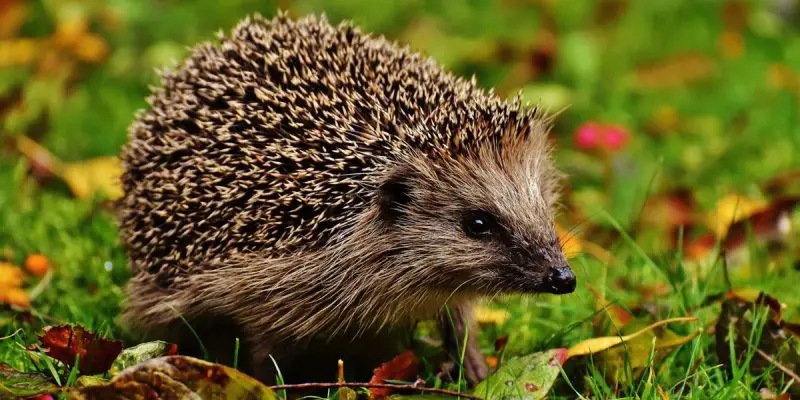At sunset on the islands of Hawaii, when the air cools and the palms quiet their rustling, the landscape comes alive with soft whispers of wind and the distant calls of seabirds. The volcanic soil still radiates heat from a day under the tropical sun, and the fragrant night-blooming flowers open like tiny lanterns glowing along forest trails.
You might imagine that somewhere beneath the hibiscus leaves or near a lava stone wall, a tiny spiny creature — a hedgehog — might be shuffling around, snuffling for insects. Many visitors and even some locals assume that a place as lush and biodiverse as Hawaii must surely host these small mammals.
But the truth is far more surprising: hedgehogs in Hawaii don’t exist in the wild at all. In fact, the islands ban them completely. And the reasons why — rooted in delicate ecosystems, ancient island evolution, and modern conservation — reveal a fascinating story of what it means to protect life on one of the world’s most vulnerable archipelagos.
This article explores everything you never knew about hedgehogs and Hawaii — myths, laws, ecological risks, biology, behavior, and why these gentle, adorable animals pose an unexpected danger to paradise.
Why Hedgehogs Are Not Found in Hawaii

No Native Hedgehog Species
Hawaii’s isolation has shaped its wildlife in unique and fragile ways. Situated thousands of miles from any major landmass, the islands formed from lava and slowly collected life through wind, driftwood, and migratory birds.
This harsh isolation meant mammals couldn’t naturally arrive — except seals and bats. All other mammals in Hawaii were introduced by humans.
There are no native hedgehog species in Hawaii, and none have ever established wild populations on the islands.
Strict Laws Protecting Island Ecosystems
Many people are surprised to learn that owning a hedgehog in Hawaii is illegal. The Hawaiian Department of Agriculture categorizes hedgehogs under “injurious wildlife” — not because they are dangerous, but because they can devastate fragile ecosystems if released or escaped.
They fall under the same prohibition class as snakes, ferrets, and many reptiles.
The reasoning is simple: Hawaii’s native species evolved without mammalian predators. Ground-nesting birds, flightless insects, and delicate native plants have no defenses against small but efficient hunters like hedgehogs.
What Would Happen If Hedgehogs Lived in Hawaii?
A Hidden Predator in Paradise
Although hedgehogs look harmless, they are surprisingly effective hunters. Their diet includes:
In Hawaii, ground-nesting birds like the ʻuaʻu (Hawaiian petrel) and nēnē goose could be at risk. Even insects unique to Hawaii — some surviving only on a single mountain ridge or forest patch — would face pressure from predation.
Because hedgehogs reproduce quickly and have few natural predators on the islands, their population could explode, overwhelming the delicate ecological webs of Hawaii.
A Threat to Agriculture
Hedgehogs could also damage Hawaiian agriculture by feeding on crops, earthworms, and beneficial invertebrates that help maintain soil quality.
Farmers already cope with introduced species like rats, mongoose, and wild pigs. Adding another mammalian predator could make the situation far more difficult.
Why People Think Hedgehogs Live in Hawaii
Viral Photos and Tourist Misconceptions
Search online for “hedgehogs in Hawaii,” and you’ll find countless pictures of hedgehogs on beaches, cliffs, and tropical gardens. These images are often:
-
Photoshopped
-
Taken in other tropical countries
-
Taken during illegal transport
-
Staged with privately smuggled animals
Tourists sometimes assume hedgehogs are native because Hawaii’s climate seems suitable, or because exotic pets are popular on social media.
This leads to one of the biggest wildlife misunderstandings among visitors: the belief that hedgehogs roam Hawaii’s forests or beaches.
The Confusion With Other Small Mammals
Some people mistake Hawaiian species for hedgehogs, including:
-
Mongooses, which are long and low to the ground
-
Polynesian rats, which forage at dusk
-
Tenrecs (in Madagascar, often mistaken for hedgehogs in media)
But none of these animals are related to hedgehogs — and none share their characteristic spines or behavior.
Understanding Hedgehogs: Biology, Behavior, and Ecology
What Makes a Hedgehog a Hedgehog?
Hedgehogs belong to the family Erinaceidae. Their unique features include:
-
A coat of defensive spines
-
Exceptional sense of smell
-
Nocturnal habits
-
Ability to curl into a tight protective ball
-
Small but powerful claws for digging
-
A diet of insects and small creatures
Their spines are modified hairs filled with keratin — light, stiff, and very effective at keeping predators at bay.
Nightlife of a Hedgehog
In their natural habitats, hedgehogs are mostly active at dusk and during the night. They roam across fields, forests, and gardens, searching for food while avoiding predators.
They rely heavily on scent — using their twitching snout to scan the air for signals, much like tiny mammals navigating through a silent, unseen world.
If hedgehogs lived in Hawaii, their nocturnal habits could create conflict with native species active at the same time, especially ground-nesting seabirds that return to colonies under cover of darkness.
Hedgehog Reproduction and Population Growth
A female hedgehog can give birth to multiple litters per year, with each litter containing four to seven hoglets. In tropical climates, breeding is nearly year-round.
In Hawaii, with its warm weather and abundant insect life, hedgehogs could breed rapidly — multiplying fast enough to alter landscapes in just a few years.
Habitat: Why Hawaii Seems Perfect for Hedgehogs — But Isn’t
Ideal Climate, Fragile Ecosystem
Hawaii’s mild temperatures, lush forests, and rich invertebrate life might seem ideal for hedgehogs. They prefer warm environments and thrive in climates between 60°F and 85°F — nearly identical to Hawaii’s year-round conditions.
But this compatibility is precisely what makes them dangerous. A single escaped hedgehog could potentially survive long enough to reproduce, threatening Hawaiian wildlife.
No Natural Predators
In Africa, Europe, and Asia, hedgehogs face predators including owls, foxes, and badgers. But Hawaii lacks these predators, which means hedgehog populations could grow unchecked.
This imbalance is the primary reason Hawaii enforces strict laws to prevent their introduction.
Hedgehogs and Humans: Why People Love Them
The Allure of the Adorable
Hedgehogs have risen in popularity due to:
-
Social media
-
Their tiny size
-
Their gentle nature
-
Their expressive behaviors
-
Their unique spiny appearance
People often desire them as pets, especially in warm regions. But in Hawaii, owning one can lead to major environmental consequences.
Illegal Pet Trade in Hawaii
Some individuals attempt to smuggle hedgehogs into Hawaii, which can result in:
-
Fines up to $200,000
-
Criminal charges
-
Confiscation and euthanasia of the animal
The law is strict not because hedgehogs are dangerous — but because Hawaii’s ecosystems are too fragile to risk their escape.
Lessons From Other Islands
The Impact of Invasive Mammals
To understand why Hawaii prevents hedgehogs, look at examples from other islands:
-
New Zealand: hedgehogs predate native insects, lizards, and birds
-
Scotland’s Outer Hebrides: hedgehogs harm ground-nesting seabirds
-
Japan: escaped hedgehogs are now invasive in several regions
These examples show that hedgehogs, though small, can reshape ecosystems dramatically.
Surprising Myths and Facts About Hedgehogs in Hawaii
-
Hedgehogs are not native to Hawaii.
-
They are illegal to own or transport.
-
Hawaii bans them to protect native birds.
-
Many tourists mistake mongooses for hedgehogs.
-
A single escaped hedgehog could establish a growing population.
-
Hedgehog photos in Hawaii are usually staged or edited.
-
Hedgehogs thrive in tropical climates, making them risky for islands.
-
Hawaii’s ecosystems evolved without mammalian predators.
-
Hedgehogs carry external parasites that could spread to local wildlife.
-
No legal exemptions exist — not even for zoos or sanctuaries.
FAQs About Hedgehogs in Hawaii
Are hedgehogs found in the wild in Hawaii?
No. There are no wild hedgehog populations in Hawaii.
Can you legally own a hedgehog in Hawaii?
No. It is completely illegal to own, transport, or breed hedgehogs in Hawaii.
Why are they banned?
Because they pose a risk to native birds, insects, and ecosystems.
Could hedgehogs survive in Hawaii?
Yes — which is exactly why they are prohibited.
Do Hawaiian zoos have hedgehogs?
No. They are illegal even for educational or zoo purposes.
What happens if someone smuggles a hedgehog into Hawaii?
Severe fines, criminal penalties, and confiscation of the animal.
Do hedgehogs harm birds?
They can eat eggs and small chicks, especially ground-nesting species.
Why do people think hedgehogs live in Hawaii?
Misleading photos and assumptions about tropical environments.
Would hedgehogs become invasive in Hawaii?
Almost certainly — based on global examples.
Are there safe alternatives?
Yes. People in Hawaii often choose legal small pets like rabbits or chinchillas.
Final Thoughts
The idea of cute hedgehogs in Hawaii may sound charming, but the truth reveals a deeper story — one about the fragility of island ecosystems and the responsibility humans hold in protecting them. Hawaii is a sanctuary shaped by millions of years of isolation, where plants and animals evolved without mainland predators.
Introducing hedgehogs, even unintentionally, would disrupt this harmony. Despite their adorable appearance and gentle nature, hedgehogs are not suitable for Hawaii’s unique environment.
Their absence from the islands is not an accident — it is a conscious effort to honor and protect one of the most extraordinary ecosystems on Earth.
Understanding this balance helps us appreciate not only the beauty of hedgehogs themselves but the precious, irreplaceable biodiversity of Hawaii — a paradise that remains wild because we choose to keep it that way.






